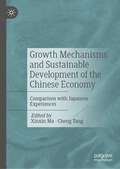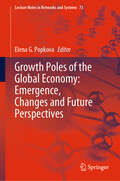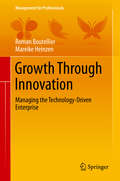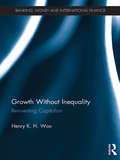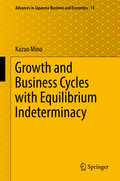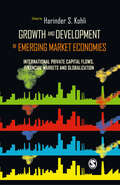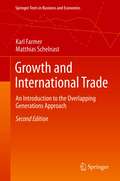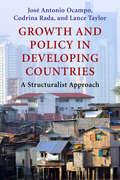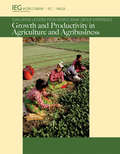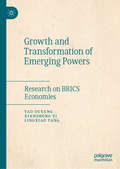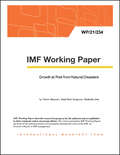- Table View
- List View
Growth Mechanisms and Sustainable Development of the Chinese Economy: Comparison with Japanese Experiences
by Xinxin Ma Cheng TangWhat can Chinese economists learn from the Japanese economic boom and subsequent stagnation? This project aims to institutionally and empirically investigate the growth mechanism and determinants of sustainable development in China compared with Japanese experiences. This is the first challenge in conducting a comparative study on China and Japan’s economic growth and development. We aim to investigate the economic system transition and its influence on the Chinese and Japanese economy from macroeconomic and microeconomic perspectives. This book will interest economists, scholars of comparative politics, and scholars of China or Japan's economic development.
Growth Poles of the Global Economy: Emergence, Changes and Future Perspectives (Lecture Notes in Networks and Systems #73)
by Elena G. PopkovaThe book presents the best contributions from the international scientific conference “Growth Poles of the Global Economy: Emergence, Changes and Future,” which was organized by the Institute of Scientific Communications (Volgograd, Russia) together with the universities of Kyrgyzstan and various other cities in Russia. The 143 papers selected, focus on spatial and sectorial structures of the modern global economy according to the theory of growth poles. It is intended for representatives of the academic community: university and college staff developing study guides on socio-humanitarian disciplines in connection with the theory of growth poles, researchers, and undergraduates, masters, and postgraduates who are interested in the recent inventions and developments in the field. It is also a valuable resource for expert practitioners managing entrepreneurial structures in the existing and prospective growth poles of the global economy as well as those at international institutes that regulate growth poles.The first part of the book investigates the factors and conditions affecting the emergence of the growth poles of the modern global economy. The second part then discusses transformation processes in the traditional growth poles of the global economy under the influence of the technological progress. The third part examines how social factors affect the formation of new growth poles of the modern global economy. Lastly, the fourth part offers perspectives on the future growth of the global economy on the basis of the digital economy and Industry 4.0.
Growth Policy in the Age of High Technology: The Role Of Regions And States (Routledge Library Editions: The Economics and Business of Technology #46)
by Robert Wilson Jurgen SchmandtOriginally published in 1990 this book provides an authoritative and detailed account of the initiatives of US state governments with science and technology programs designed to foster economic growth. Two key questions are posed: Do state governments have policy instruments that are sufficiently powerful to affect thelevels and growth rates of their regional economies? and Are national and global economic forces so powerful that they render state action ineffective? Several subsidiary themes are discusses in this context, namely: the most commonly used policy instruments, the impacts on federalism and on governance and how well the universities and other educational institutions serve the economic activities imposed on them.
Growth Theory and Growth Policy (Routledge Studies In International Business And The World Economy Ser. #Vol. 30)
by Harald Hagemann Stephan SeiterThis collection examines the phenomenon of economic growth with admirable economic vigour and includes contributions from leading academic figures. Theoretical approaches, underpinned by original empirical work, will make this a book welcomed by students and academics of macroeconomics and growth theory.
Growth Through Innovation
by Roman Boutellier Mareike HeinzenCapitalism produced entrepreneurs and property rights, the two basic pillars of innovation and growth. As the speed of technology is steadily increasing only radical innovation can be the name of the game. This book discusses technology and innovation trends by looking into historical examples and telling the latest business stories. It opens the discourse about pirates, pioneers, innovators and imitators; proposes the framework of dominant, science-driven and high-tech industry for innovation management and gives insights into intellectual property rights, industrial designs and technical risk management. Finally, it offers 8 important innovation principles for technology driven enterprises that have turned out to have a big effect on the outcome - and in the end on growth.
Growth Without Inequality: Reinventing Capitalism (Banking, Money and International Finance)
by Henry K. WooMany years on after the 2007–8 financial crisis, most developed nations still find themselves in a state of weak recovery, high debt pile-up and distributive disparity. The intriguing question that we face is whether the golden days of modern capitalism are over, or if capitalism is just undergoing another period of adjustment characteristic of its past. What is disheartening is that the twin economic goals of sustainable growth and equality, which the world has now come to recognise as of paramount importance but mutually conflicting, remain, more now than ever, illusive and unattainable. Growth Without Inequality attempts to address this issue and to provide a pragmatic solution especially for nations in the current policy gridlock. By offering a unified framework of factors that drive growth, it shows how growth also gives rise to an array of "anomalous market forms" (defined by different degrees of value and risk visibility) that subvert distributive equity between labour and capital. It debunks both the pure free market solution and the mixed economy approach on the ground that they fail to arrest the growth propelling yet subversive power inherent in the "corporate forms" under the present capitalistic regime. Having shown that effective reform can hardly take place within the system itself, this book proposes to build a separate sector (Economy II) and partition it from the existing system (Economy I). The solution is easy to implement and quick to take effect. By one single stroke, this "Non-Marxist" solution can happily achieve the ideals of both "competitive capitalism" and "egalitarian socialism".
Growth and Business Cycles with Equilibrium Indeterminacy
by Kazuo MinoOver the past two decades, the issue of equilibrium indeterminacy has been one of the major research concerns in macroeconomic dynamics. Growth and Business Cycles with Equilibrium Indeterminacy discusses the main topics in this literature. Based on comprehensive surveys and the author's original research, this book explores sunspot-driven fluctuations in real business cycle models, multiple equilibria in endogenous growth models, and the relation between fiscal policy and indeterminacy. The book also considers indeterminacy in open economy models as well as in models with financial frictions and price rigidity.
Growth and Capital Flows with Risky Entrepreneurship
by Damiano SandriA report from the International Monetary Fund.
Growth and Competitive Strategy in 3 Circles
by Joel E. Urbany James H. DavisGrowth and competitive advantage are about effective positioning. Building effective positioning is challenging today for firms facing new and stronger competition, volatile and uncertain markets, and shifting customer desires and demands. The 3-Circle model facilitates speed of understanding and action by focusing attention on the most critical strategy concepts in this uncertain environment. Growth strategy emerges in the model from systematically addressing four key strategy directives in a deep and disciplined way: 1. define, build, and defend the unique value you create for customers; 2. correct, eliminate, or reveal value that is failing customers, which they're not aware of; 3. potentially neutralize the unique value created for customers by competitors; 4. explore and exploit new growth opportunities through deep understanding of customers' unmet needs.
Growth and Crisis in the Spanish Economy: 1940-1993 (Routledge Studies in the European Economy)
by Sima LiebermanAppraises the turbulent development of the Spanish economy over the last fifty years and places current economic problems in their historical context. The author examines the economic, political and social problems inherited from the Franco era and their evolution into the present. The book includes: * a detailed discussion of economic development under Franco, including the boom years of the 1960s followed by the decline of the early 1970s; *an analysis of the decade of economic crisis which only ended in 1985; *an evaluation of the economic successes achieved by the Gonzalez government during the second half of the 1980s; *an analysis of why, despite serious attempts to revitalize the industrial sector, Spain still has one of the highest levels of unemployment in the OECD.
Growth and Decline of American Industry: Case studies in the Industrial History of the USA (Routledge Focus on Industrial History)
by John F. Wilson Steven Toms Nicholas D. WongThis shortform book presents key peer-reviewed research selected by expert series editors and contextualised by new analysis from each author on how the specific field addressed has evolved. The book features contributions on the history of government-business relations, regional and local business relationships, the development and formation of Silicon Valley, and the rise and fall of the US machine tool industry after the Second World. Of interest to business and economic historians, this shortform book also provides analysis that will be valuable reading across the social sciences.
Growth and Development in Emerging Market Economies: International Private Capital Flow, Financial Markets and Globalization
by Harinder S. KohliThis compilation helps understand the basic forces that are now determining the performance and prospects of emerging market economies (EMEs) around the world. In the past few years, there has been a sharp rise in private capital flows to well performing developing countries, commonly referred to as EMEs. With a drop in net transfers from official sources, the private capital flows in these countries now dwarf official flows. Growth and Development in Emerging Market Economies: International Private Capital Flows, Financial Markets and Globalization encapsulates in one volume the understanding of the inter-related topics of global imbalances, finance, investment, trade, and infrastructure. Such assemblage is difficult to find in the existing literature in this field. Many chapters discuss the situations in Asia and Latin America, drawing parallels and pointing out contrasts. The papers in this collection were discussed at the Emerging Markets Forum meeting held in Jakarta, Indonesia in September 2006. The contributors include highly experienced former policy makers and senior officials of multilateral institutions who have lifelong experience in policy formulation at the highest level. The collection would be of value to policy makers in developing countries, officials of multilateral development institutions and researchers and academicians in the field of EMEs.
Growth and Development in the Global Political Economy: Modes of Regulation and Social Structures of Accumulation (Routledge Frontiers of Political Economy)
by Phillip O'HaraRecent institutional changes have seen the increasing dominance of globalization and neoliberalism in the world economy. As markets have been deregulated, privatization and unproductive government spending have been promoted. Yet the greater volatility of capitals, the emergence of many financial crises, a decline in trust, and environmental problems have cast doubt on the effectiveness of neoliberal globalization. This book studies the impact of neoliberal globalization on growth and development in the world economy. It scrutinizes whether new social structures of accumulation or modes of regulation have emerged to promote long-term socioeconomic performance in the global economy during the early years of the twenty-first century. Special reference is given to the specific performance of neoliberal governance; transnational corporations; global institutions of money, trade and production; international relations of war and terrorism; financial institutions; and the family-community environment. It is a comprehensive analysis of the degree to which institutional development has managed to promote socioeconomic performance in the global economy. It also presents a thorough policy program of action for long wave upswing in the world economy. It will be especially useful for those scholars and students concerned with issues of governance, global political economy, institutions and macroeconomics
Growth and Distribution: Second Edition
by Duncan K. FoleyAuthors Foley, Michl, and Tavani offer a major revision of an established textbook on the theory, measurement, and history of economic growth, with new material on climate change, corporate capitalism, and innovation.
Growth and Fluctuations 1870-1913 (Routledge Revivals)
by W. Arthur LewisIn this title, first published in 1978, Sir Arthur Lewis considers the development of the international economy in the forty years leading up to the First World War, with the adoption of the gold standard, a rapid growth in world trade, the opening up of the continents by the railways, vast emigration from Europe, India and China, and large-scale international investment. The book contrasts the relationship between prices, industrial fluctuations, agricultural output, and the stock of monetary gold, considering both the varying patterns of leading economies and then their net combined effect on the rest of the world. This is history which illuminates the contemporary economic climate in which it was written but also casts light upon our current economic crisis.
Growth and Institutions in African Development (Routledge Studies in Development Economics)
by Augustin K. FosuRecent years have seen a sustained research effort exploring the African development experience. The extant literature has offered a large set of explanations as to why the African development record has lagged behind that of other regions of the developing world. This new volume brings international contributors together to focus on the role of growth and institutions. First, it provides brief evidence on the growth and institutional records, as well as on development outcomes, during the post-independence period. Second, it targets certain growth determinants, including industrial embeddedness, innovation, exchange rate regimes, and environmental quality. Third, it sheds light on the dynamics and distribution of growth, and on growth-enhancing sectors of the economy. Finally, it investigates several issues of institutional development, as well as institutions generating development outcomes. Though focused on these two key areas, the coverage strives to achieve a comprehensive analysis of how Africa’s development may have been enhanced or undermined and to offer lessons for the future. This volume is essential reading for all scholars of development economics and development studies.
Growth and International Trade
by Karl Farmer Matthias SchelnastThis textbook guides the reader towards various aspects of growth and international trade in a Diamond-type overlapping generations framework. Using the same model type throughout the book, timely topics such as growth with bubbles, debt reduction in rich countries and policies to mitigate climate change are explored . The first part starts from the "old" growth theory and bridges to the "new" growth theory (including R&D and human capital approaches). The second part presents an intertemporal equilibrium theory of inter and intra-sectoral trade and concludes by analyzing the debt mechanics inducing the huge imbalances among eurozone countries. The book is primarily addressed to graduate students wishing to proceed to the analytically more demanding journal literature.
Growth and International Trade: An Introduction to the Overlapping Generations Approach (Springer Texts in Business and Economics)
by Karl Farmer Matthias SchelnastRevised and updated for the 2nd edition, this textbook guides the reader towards various aspects of growth and international trade in a Diamond-type overlapping generations framework. Using the same model type throughout the book, timely topics such as growth with bubbles, robots and involuntary unemployment, financial integration and house price dynamics, policies to mitigate climate change and the persistence of religion in a globalized market economy are explored.The first part starts from the “old” growth theory and bridges to the “new” growth theory (including R&D and human capital approaches). The second part presents an intertemporal equilibrium theory of inter- and intra-sectoral trade, investigates innovation, growth and trade and limits to public debt as well as nationally and internationally optimal climate policies. The debt dynamics of the Euro Zone and the origins of intra-EMU and Asian-US trade imbalances are also explored.The book is primarily addressed to upper undergraduate and graduate students wishing to proceed to the analytically more demanding journal literature.
Growth and Policy in Developing Countries: A Structuralist Approach
by Lance Taylor Jose Antonio Ocampo Codrina RadaEconomic structuralists use a broad, systemwide approach to understanding development, and this textbook assumes a structuralist perspective in its investigation of why a host of developing countries have failed to grow at 2 percent or more since 1960. Sensitive to the wide range of factors that affect an economy's strength and stability, the authors identify the problems that have long frustrated growth in many parts of the developing world while suggesting new strategies and policies to help improve standards of living. After a survey of structuralist methods and post-World War II trends of global economic growth, the authors discuss the role that patterns in productivity, production structures, and capital accumulation play in the growth dynamics of developing countries. Next, it outlines the evolution of trade patterns and the effect of the terms of trade on economic performance, especially for countries that depend on commodity exports. The authors acknowledge the structural limits of macroeconomic policy, highlighting the negative effects of financial volatility and certain financial structures while recommending policies to better manage external shocks. These policies are then further developed through a discussion of growth and structural improvements, and are evaluated according to which policy options-macro, industrial, or commercial& mdash;best fit within different kinds of developing economies.
Growth and Policy in Developing Countries: A Structuralist Approach (Initiative for Policy Dialogue at Columbia: Challenges in Development and Globalization)
by Lance Taylor José Antonio Ocampo Codrina RadaEconomic structuralists use a broad, systemwide approach to understanding development, and this textbook assumes a structuralist perspective in its investigation of why a host of developing countries have failed to grow at 2 percent or more since 1960. Sensitive to the wide range of factors that affect an economy's strength and stability, the authors identify the problems that have long frustrated growth in many parts of the developing world while suggesting new strategies and policies to help improve standards of living.After a survey of structuralist methods and post-World War II trends of global economic growth, the authors discuss the role that patterns in productivity, production structures, and capital accumulation play in the growth dynamics of developing countries. Next, it outlines the evolution of trade patterns and the effect of the terms of trade on economic performance, especially for countries that depend on commodity exports. The authors acknowledge the structural limits of macroeconomic policy, highlighting the negative effects of financial volatility and certain financial structures while recommending policies to better manage external shocks. These policies are then further developed through a discussion of growth and structural improvements, and are evaluated according to which policy options-macro, industrial, or commercial-best fit within different kinds of developing economies.
Growth and Poverty Reduction in Armenia
by Garbis Iradian Enrique Gelbard Jimmy Mchugh Christian Beddies Laure RediferThis publication examines Armenia's economic transformation during the past 10 years, focusing on the recent period of economic stability, strong economic growth, and poverty reduction, and on the challenges to sustaining these successes.
Growth and Productivity in Agriculture and Agribusiness
by World Bank StaffThe report assesses the World Bank Group's support for growth and productivity in the agriculture sector. Enhancing agricultural growth and productivity is essential to meeting the worldwide demand for food and to reducing poverty, particularly in the poorest developing countries. Between 1998 and 2008, the period covered by this evaluation, the World Bank Group (WBG) provided $23.7 billion in financing for agriculture and agribusiness in 108 countries (roughly 8 percent of total WBG financing), spanning areas from irrigation and marketing to research and extension. However, this was a time of declining focus on agricultural growth and productivity by both countries and donors. The cost of inadequate attention to agriculture, especially in agriculture-based economies, came into focus with the food crisis of 2007-08. The crisis added momentum to an emerging renewal of attention and stepped-up financing to agriculture and agribusiness at the World Bank and International Finance Corporation (IFC), as well as at several multilateral and bilateral agencies. World Bank financing rose two and a half times from 2008 to 2009, though that increase in lending seems to have been accompanied by a decline in analytical work, which this review finds valuable for results. This evaluation seeks to provide lessons from successes and failures to help improve the development impact of the renewed attention to the sector. Ratings against the World Bank's stated objectives and IFC's market-based benchmarks for agriculture and agribusiness projects have been equal to or above portfolio averages in East Asia, Latin America, and the transition economies in Europe, with notable successes over a long period in China and India. But performance of WBG interventions has been well below average in Sub-Saharan Africa, where IFC has had little engagement in agribusiness. Inconsistent client commitment and weak capacity have limited the effectiveness of WBG support in agriculture-based economies, particularly in Sub-Saharan Africa, and constraints on staffing and internal coordination within the WBG have also hurt outcomes. Financial sustainability has been constrained by insufficient government funding and the difficulty of maintaining agricultural services and infrastructure. The WBG has a unique opportunity to match the increases in the financing for agriculture with sharper focus on improving agricultural growth and productivity in agriculture-based economies, notably in Sub-Saharan Africa. Greater effort will be needed to connect sectoral interventions and achieve synergies from public and private sector interventions; to build capacity and knowledge exchange; to take stock of experience in rain-fed agriculture; to ensure attention to financial sustainability and to cross-cutting issues of gender, environmental and social impacts, and climate; and to better integrate WBG support at the global and regional levels with that at the country level.
Growth and Structural Reforms: A New Assessment*
by Lone Christiansen Thierry Tressel Martin SchindlerA report from the International Monetary Fund.
Growth and Transformation of Emerging Powers: Research on BRICS Economies
by Yao Ouyang Xianzhong Yi Lingxiao TangThis book offers a quantitative and qualitative look at the much-discussed BRICS—Brazil, Russia, India, China and South Africa—and explores how their economic ascent might cause global economic realignments in the 21st century. Providing a Chinese perspective on how the global realignment might impact strategic choices and a data-driven approach to the similarities and differences within the so-called BRICS group, this book will be of great interest to economists, international banking professionals, and political forecasters.
Growth at Risk from Natural Disasters (Imf Working Papers)
by Tamim Bayoumi, Saad Noor Quayyum, Sibabrata DasA report from the International Monetary Fund.
